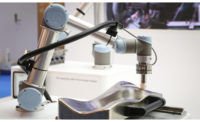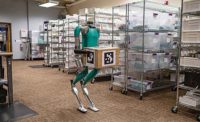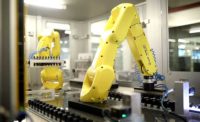The stock of operational robots around the globe hit a new record of about 3.9 million units last year. This demand has been driven by a number of exciting technological innovations, and it’s a good bet 2024 will set a new record, as well.
According to the International Federation of Robotics, here are the top five trends in robotics for 2024. See if you can apply them to your operation.
Artificial Intelligence (AI) and Machine Learning
AI promises to make robots easier to use than ever before. Robot manufacturers are developing generative AI-driven interfaces that allow users to program robots more intuitively by using natural language instead of code. Workers will no longer need specialized programming skills to select and adjust the robot’s actions.
Another example is the use of AI for predictive maintenance. AI can be used to analyze performance data to assess the future health of robotic equipment with the goal of preventing unplanned downtime. Predictive maintenance can save manufacturers billions of dollars. In the auto parts industry, for example, each hour of unplanned downtime is estimated to cost $1.3 million.
Machine learning algorithms can also analyze data from multiple robots performing the same process. This can help engineers optimize production. In general, the more data a machine learning algorithm is given, the better it performs.
Cobots Expanding to New Applications
Human-robot collaboration continues to be a major trend in robotics. Rapid advances in sensors, vision technologies and smart grippers allow robots to respond in real-time to changes in their environment and thus work safely alongside human workers.
Collaborative robot applications offer a new tool for human workers, relieving and supporting them. They can assist with tasks that require heavy lifting or repetitive motions. They can also work in dangerous environments.
The range of collaborative applications offered by robot manufacturers continues to expand.
A recent market development is the increase of cobot welding applications, driven by a shortage of skilled welders. This demand shows that automation is not causing a labor shortage, but rather offers a means to solve it. Collaborative robots will therefore complement—not replace—investments in traditional industrial robots, which operate at much faster speeds and will therefore remain important for improving productivity in response to tight product margins.
New OEMs are entering the market with a specific focus on collaborative robots. Mobile manipulators—the combination of collaborative robot arms and autonomous mobile robots (AMRs) —offer new use cases that could expand the demand for collaborative robots substantially.
Mobile Manipulators
Mobile robot manipulators—so called MoMas—are automating material handling tasks in industries such as automotive, logistics and aerospace. They combine the mobility of robotic platforms with the dexterity of manipulator arms. This enables them to navigate complex environments and manipulate objects, which is crucial for applications in manufacturing. Equipped with sensors and cameras, these robots perform inspections and carry out maintenance tasks on equipment. A significant advantage of mobile manipulators is their ability to collaborate with human workers. The ongoing skilled labor shortage will only increase demand for this technology.
Digital Twins
Digital twin technology is increasingly used as a tool to optimize the performance of a physical systems by creating a virtual replica. Since robots are more and more digitally integrated in factories, digital twins can use their real-world operational data to run simulations and predict likely outcomes. Because the twin exists purely as a computer model, it can be stress-tested and modified with no safety implications while saving costs. All experimentation can be checked before the physical world itself is touched. Digital twins bridge the gap between digital and physical worlds.
Humanoid Robots
Once the realm of science fiction, humanoid robots are finally being introduced. Robots with two arms and two legs are moving out of the college laboratory and into warehouses and factories—environments that were once the sole province of people.
The Chinese Ministry of Industry and Information Technology (MIIT) recently published detailed goals for the country’s ambitions to mass-produce humanoid robots by 2025. The MIIT predicts humanoid robots are likely to become another disruptive technology, similar to computers or smartphones, that could transform the way we produce goods and the way humans live.
The potential impact of humanoid robots on various sectors makes them an exciting area of development, but their mass market adoption remains a challenge. Costs are a key factor, and success will depend on their return on investment competing with well-established robot technologies, such as mobile manipulators.
What do you think? Can one of these trends make it into your assembly plant? What do you see as the next steps for robotics in manufacturing?




